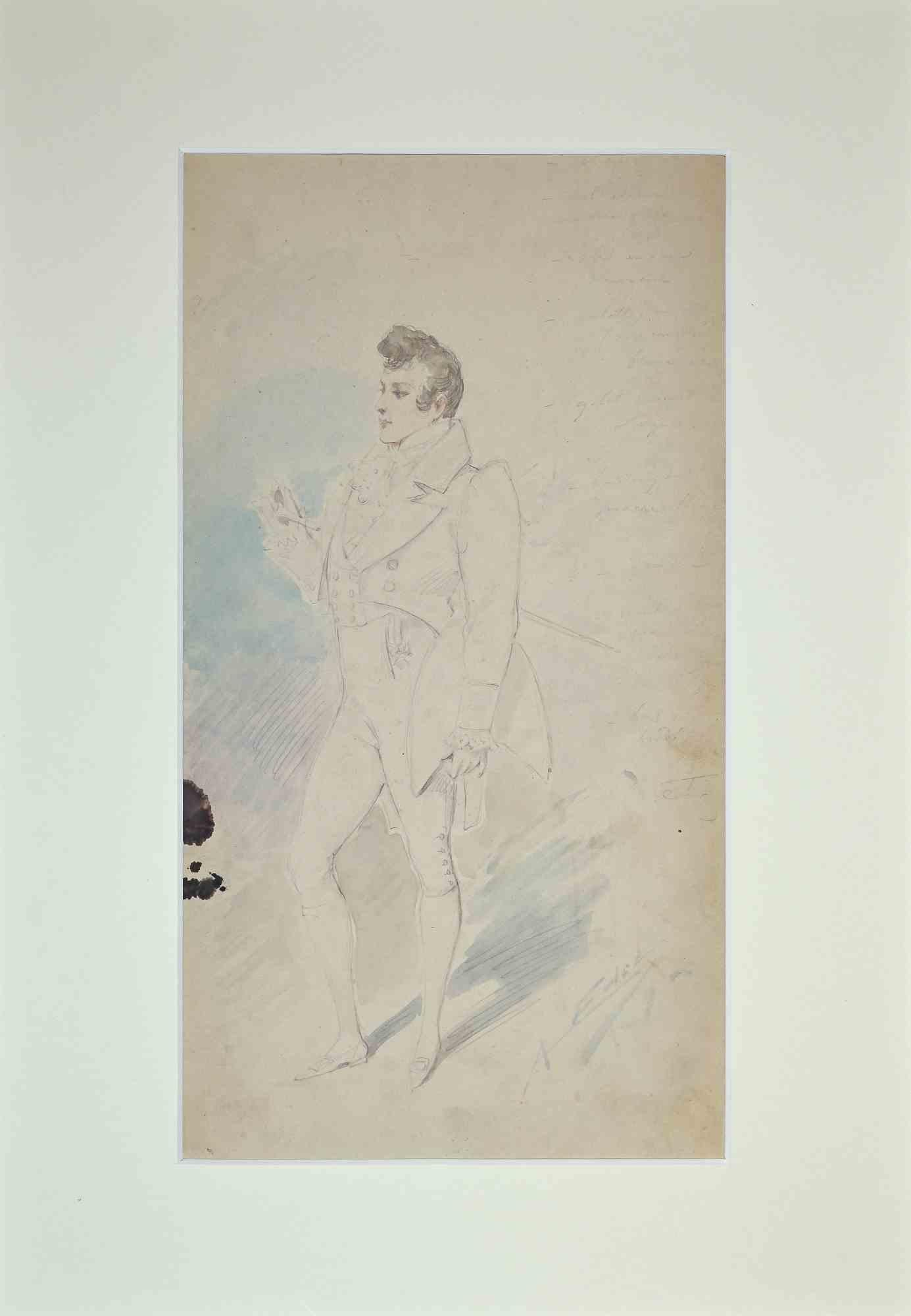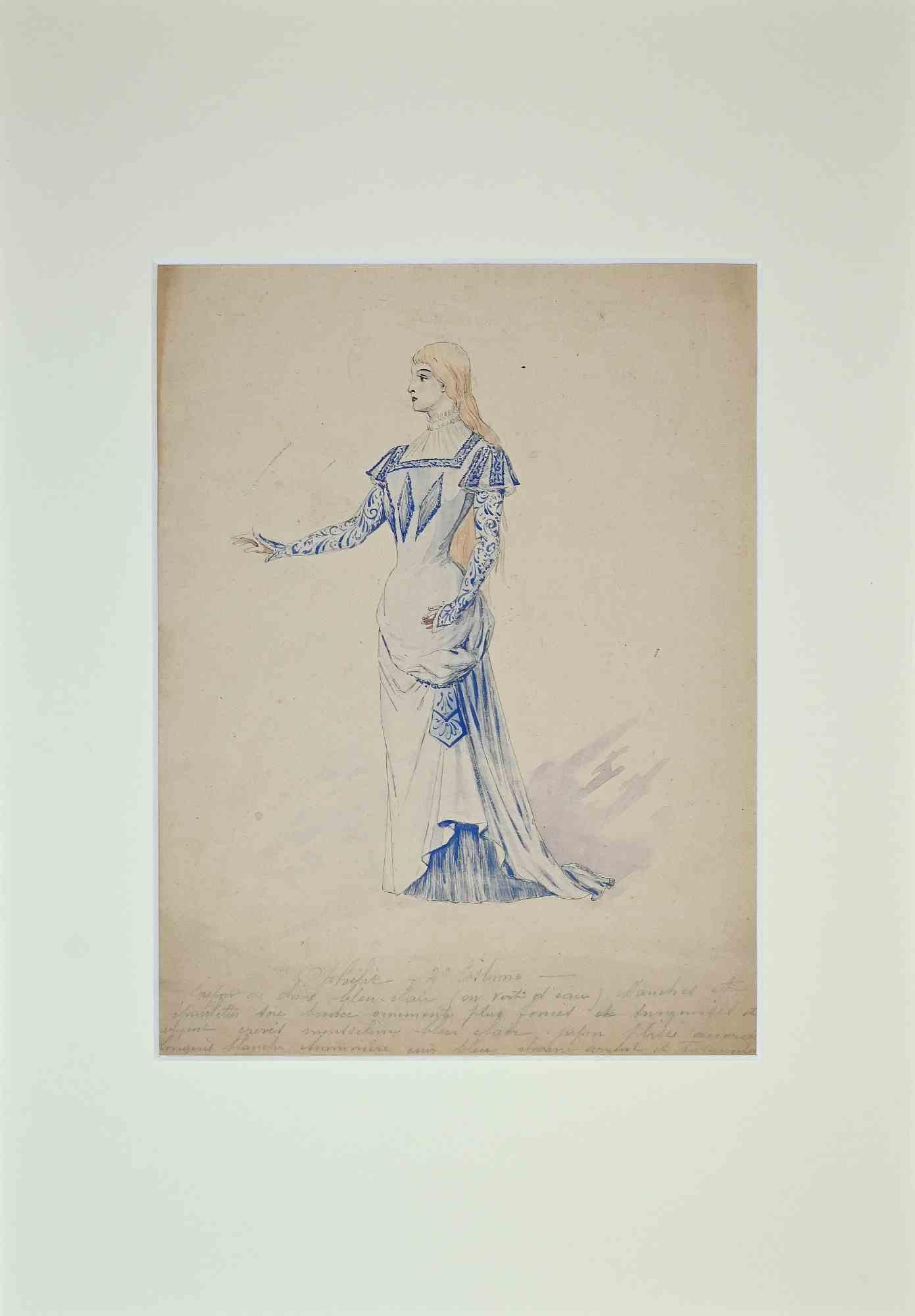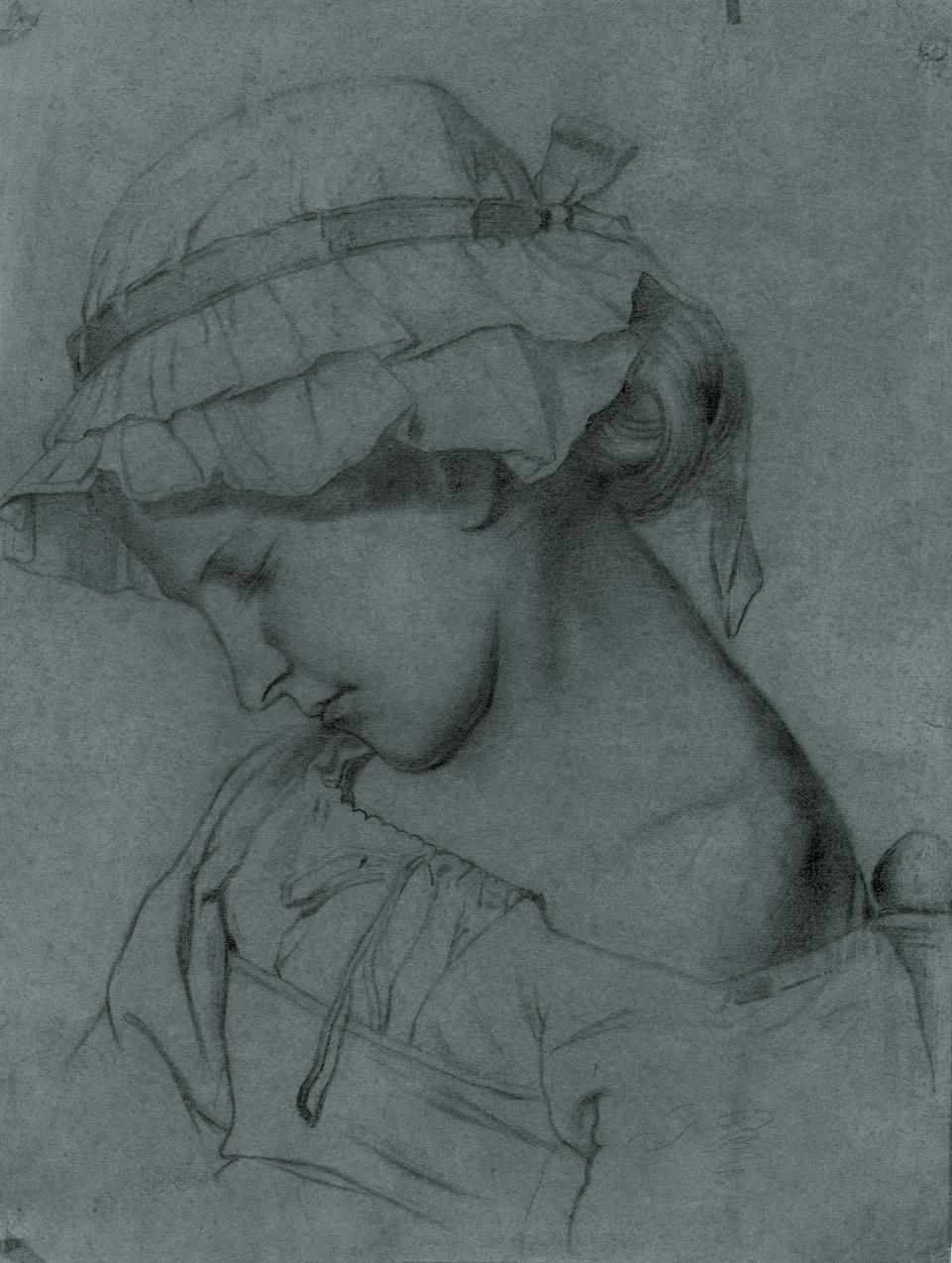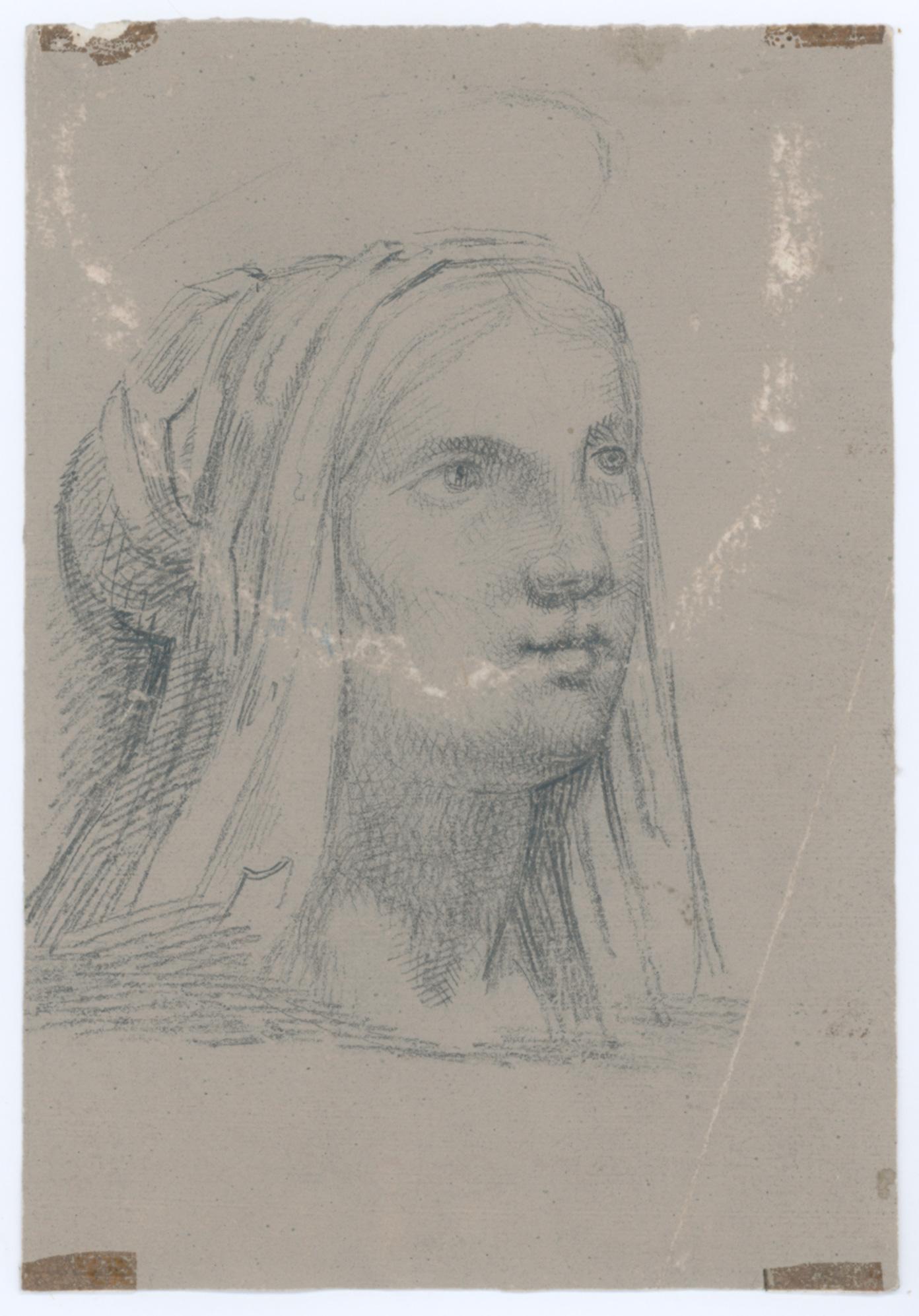Items Similar to Portrait drawing of Harriot Mellon, Mrs Thomas Coutts
Want more images or videos?
Request additional images or videos from the seller
1 of 6
Henry FuseliPortrait drawing of Harriot Mellon, Mrs Thomas Coutts1815
1815
About the Item
Inscribed by the artist in pen and brown ink, upper margin: 'σοφὴν δὲ μισῶ: μὴ γὰρ ἔν γ' ἐμοῖς δόμοις / εἴη φρονοῦσα πλείον' ἢ γυναῖκα χρή [Euripides, Hippolytus, 11, 640-41: “But a clever woman - that I loathe! May there never be in my house a woman with more intelligence than befits a woman!”]; inscribed and dated, lower margin, H[arriot]. M[ellon]., and, S[omerset]. H[ouse]. may 29. [18]15.; and inscribed on the verso, Covent Garden Theatre / Admit seven to my box / T. Coutts / Saturday May 13th 1815'
Collections:
Sir Thomas Lawrence PRA, acquired from Fuseli’s estate;
Susan Coutts, Baroness North and Countess of Guilford (d. 1837), acquired in 1830 from Lawrence’s estate;
Susan, 10th Baroness North, daughter of the above (d. 1884);
North sale, Sotheby’s, 14 July 1885, lot 654 (one of six autographs “mostly with sketches”), bought by Harvey, £1.10s;
Ralph Edward Lambton;
Christie’s, 9 December 1980, lot 275;
Stanley J. Seeger.
Framed dimensions: 15.50 x 13 inches
This highly worked, intelligent and incisive portrait was made by Henry Fuseli in his rooms at the Royal Academy in Somerset House. The subject was the celebrated actress, Harriot Mellon, who had recently married Fuseli’s great friend and patron, the banker, Thomas Coutts. Coutts had sponsored Fuseli’s trip to Rome in 1770 and remained a life-long support of the artist and his work. This powerful, carefully observed profile portrait is a testament to the intimacy between Fuseli and Coutts.
The daughter of itinerant actors, Mellon, famous for her beauty, made her debut in London at the Drury Lane Theatre as Lydia Languish in Sheridan's The Rivals in 1795. Anne Matthews, a fellow actress described her as: ‘a young, glowing beauty, endued with great natural powers of mind, talents and vivacity, but ... an insuperable rusticity of air and manners.’ Mellon retired from the stage in February 1815, shortly after her marriage to Coutts, he was seventy-eight, forty years older than Mellon.
Fuseli produced a number of intense studies of women throughout his career. Frequently fantastical and eroticized, these drawings often show women at their toilet, dressing their hair or in a state of undress. This intensely worked sheet preserves something of Fuseli’s interest in women’s hair. Her hair is worked with a graphic intensity which recalls both Etruscan vase painting and the spare line engravings of John Flaxman. The drawing is inscribed with the date and location ‘S.H.’ referring to Somerset House, the home of the Royal Academy, where Fuseli had a studio in his capacity as Keeper of the Royal Academy Schools. In a characteristic mode, Fuseli has also inscribed the drawing with two lines of Greek. The quotation comes from Euripides’s Hippolytus and translates as: ‘But a clever woman - that I loathe! May there never be in my house a woman with more intelligence than befits a woman!’ The ambiguity of this sentiment is entirely typical of Fuseli’s deployment of text within his images, but it may also point to a dissatisfaction at seeing his oldest friend and patron marry an actress in old age?
With sparse use of his media and without unnecessary embellishments, Fuseli captured the extrinsic features as well as the character of his sitters. One of the young women Fuseli frequently portrayed at the time was Lavinia de Irujo, daughter of a Spanish diplomat, then living in Chelsea. She, like one of Coutts’s grand-daughters, Lady Georgina North, had received drawings lessons from the artist. Two portraits of Lavinia, made in 1813 and 1814, respectively, are particularly close in style and type to our sheet. The earlier one shows Lavinia with an almost identical coiffure, her name inscribed in Greek letters. Fuseli often inscribed his drawings in Greek; a characteristic sheet comparable to ours is a drawing of a courtesan, identical in style, medium and size, in the Kunsthalle, Hamburg, which bears a similar two-line Greek inscription, this time quoted from Homer’s Iliad.
Fuseli lived in some intimacy with the Coutts family. He would often stay with Susan, Coutts’s eldest daughter, then Countess of Guilford, at her house in Putney Hill; in that familial context Fuseli made many of his intimate portrait drawings, and it was there that Fuseli, surrounded by the adoring members of the Coutts family and other friends, such as Thomas Lawrence, died in 1825. All of Fuseli’s drawings and sketches, including the present sheet, were then purchased by Lawrence, and after his death entered the possession of the Countess of Guilford, through whose family they descended.
- Creator:Henry Fuseli (1741 - 1821, Swiss)
- Creation Year:1815
- Dimensions:Height: 7 in (17.78 cm)Width: 4.5 in (11.43 cm)
- Medium:
- Movement & Style:
- Period:
- Condition:Preserved in excellent condition and housed in a giltwood frame.
- Gallery Location:London, GB
- Reference Number:1stDibs: LU150727722312
About the Seller
5.0
Recognized Seller
These prestigious sellers are industry leaders and represent the highest echelon for item quality and design.
1stDibs seller since 2021
- ShippingRetrieving quote...Ships From: London, United Kingdom
- Return PolicyA return for this item may be initiated within 14 days of delivery.
More From This SellerView All
- Regency portrait drawing of Lady NugentBy John DownmanLocated in London, GBCollections: With Ellis Smith, London; Private collection, to 2015. Literature: G.C. Williamson, John Downman A.R.A., his Life and Works, p. lviii no...Category
19th Century Old Masters Portrait Drawings and Watercolors
MaterialsWatercolor, Pencil
- 18th century ink study for the Leveson-Gower ChildrenBy George RomneyLocated in London, GBCollections: J. Goodfriend, USA. Brown wash and pencil on laid paper Framed dimensions: 13.25 x 11.75 inches This powerful drawing was made at the time that Romney was painting the famous group portrait of the Gower Children now in Abbot Hall Art Gallery, Kendal. Romney was a bold and incisive draughtsman who made numerous rich brown ink studies, principally for historical compositions; by contrast, comparatively few studies linked directly to his portraits survive. The existence of a group of studies for the Gower Children underscores its importance to Romney. The sitters were the five youngest of the eight children of Granville, 2nd Earl Gower who, at the time the portrait was commissioned, was President of the Council in Lord North’s government and one of the best-connected and most influential people in England. The present drawing which is a large scale treatment of the composition in its final form perfectly distils Romney’s conceit: the younger children dancing whilst their elder sister, in the guise of a Bacchante plays the tambourine. The bold and dramatic study underlines both the artistic confidence and classical grandeur Romney gained during his trip to Italy between 1773 and 1775. The commission from Granville, 2nd Earl Gower to paint five of his children came shortly after Romney’s Continental tour. The initial idea, as represented by the present drawing, seems to have been to paint Lady Anne, the figure on the right of the composition playing the tambourine, who was the youngest of Gower’s first four children by his second wife Lady Louisa Egerton and who married the Rev. Edward Vernon Harcourt, later Archbishop of York, with three of her younger half-siblings by Gower’s third wife, Lady Susanna Stewart: at the left Lady Georgina, who became Countess of St Germans following her marriage to the Hon. William Eliot; at the right Lady Charlotte Sophia, later Duchess of Beaufort and in the centre Lady Susanna, later Countess of Harrowby. Romney added a fifth child to the finished portrait, Gower’s son: Lord Granville, later created Viscount Granville and Earl Granville. In Italy Romney had produced a large number of studies of classical antiquities and old master paintings. The commission from Gower offered Romney the opportunity to explore a complex multi-figural group, putting into practice the kind of ambitious classical quotations that Reynolds was currently exploiting. In 1773 Reynolds had completed the remarkable group portrait of the Montgomery Sisters, now in the Tate Gallery, London, which showed them adorning a herm of the Roman god Hymen; the composition used a garland to link the three figures who were shown in classical costume dancing at the foot of a Roman sculpture. Scholars have long pointed to a similar sources for the two compositions: the works of Nicolas Poussin. Whilst the Montgomery Sisters is based, in part, on a Bacchanal now in the Musée des Beaux-Arts, the Gower Children has always been associated with Poussin’s Dance to the Music of Time, now in the Wallace Collection, London. It seems more likely that Romney was looking to an antique source in the form of the Borghese Dancers, a Roman relief, then in Palazzo Borghese in Rome. Romney would have seen the relief of interlocking, dancing maidens and would also have known Guido Reni’s Aurora...Category
18th Century Old Masters Portrait Drawings and Watercolors
MaterialsPencil, Ink
- 18th century portrait drawing of the Rev. William AtkinsonBy George RomneyLocated in London, GBCollections: Henry Scipio Reitlinger (1882-1950); Private collection, UK to 2019 Framed dimensions: 14.50 x 15.38 inches This drawing is one of only two known portrait drawings by Romney (as opposed to preliminary studies for portraits) and is dated by Alex Kidson as being executed no later than 1769. It is likely that the present drawing was originally part of a sketchbook, now largely dismembered (Abbot Hall Art Gallery, Kendal), which Kidson notes, contained some of Romney’s most beautiful early drawings. This drawing, and a second sheet formerly with Andrew Wyld, have been identifying as depicting the Rev. William Atkinson...Category
18th Century Old Masters Portrait Drawings and Watercolors
MaterialsPencil
- Regency portrait drawing of Arabella Graham-ClarkeBy John DownmanLocated in London, GBCollections: The sitter, and by descent; Christie's, 19th March 1928, lot 6; Private collection to 2019 Literature: G.C. Williamson, John Downman, A.R.A., his Life and Works, Lon...Category
Early 19th Century Old Masters Portrait Drawings and Watercolors
MaterialsWatercolor, Pencil
- 18th century pastel portrait of Lady Augusta Corbett and her son, StuartBy Daniel GardnerLocated in London, GBCollections: Commissioned by Andrew Corbett, husband of the sitter; The Venerable Stuart Corbett; Sir Stuart Corbett; By descent to 2002; Sotheby’s, London 21 March 2002, lot.104; Lowell Libson...Category
18th Century Old Masters Portrait Drawings and Watercolors
MaterialsGouache, Pastel
- 18th century portrait of the Royal Academy model George WhiteBy John RussellLocated in London, GBCollections: Russell sale, Christie’s, 14 February, 1807: ‘John Russell, Esq., R.A. deceased, crayon painter to His Majesty, the Prince of Wales, and Duke of York; and brought from his late Dwelling in Newman Street’, lot 92, ‘St Peter’, bt. Thompson (£1.13s); Anonymous sale; Sotheby's, London, 25th September 1980, lot 113; Private collection, UK, 2016. Literature: Martin Postle, 'Patriarchs, prophets and paviours: Reynolds's images of old age', The Burlington Magazine, vol. cxxx, no. 1027, October 1988, pp. 739-40, fig. 9; Martin Postle, Sir Joshua Reynolds: The Subject Pictures, Cambridge, 1995, p.136, repr.; Neil Jeffares, Dictionary of pastellists before 1800, online edition, J.64.2928. Signed and dated: J Russell/ fecit 1772 (lower right) Framed dimensions: 25 x 31 inches John Russell was admitted to the Royal Academy in March 1770, at the same time as Daniel Gardner. The nascent Academy Schools were still establishing their teaching structures, but central to the syllabus were the twin components of drawing after the antique and from life models. By 1772 Russell had already been awarded a silver medal and progressed to the life academy, where he produced this remarkable pastel study of George White. White was the most famous model employed by the Royal Academy and prominent artists in the second half of the eighteenth century. A paviour – or street mender –by profession White had been discovered by Joshua Reynolds, who in turn introduced him to the Academy. Russell’s striking head study demonstrates his abilities as a portraitist and pastellist, at the same time showing his interest in the Academy’s preoccupation with promoting history painting. George White was one of the most celebrated models in eighteenth-century London. According to the painter Joseph Moser: 'Old George…owed the ease in which he passed his latter days, in a great measure to Sir Joshua Reynolds, who found him exerting himself in the laborious employment of thumping down stones in the street; and observing not only the grand and majestic traits of his countenance, but the dignity of his muscular figure, took him out of a situation to which his strength was by no means equal, clothed, fed, and had him, first as a model in his own painting room, then introduced him as a subject for the students of the Royal Academy.' As Martin Postle has pointed out, whilst characterful studies of old men posed as biblical figures, prophets or saints by Continental old masters were readily available on the art market – Reynolds himself had copied a head of Joab by Federico Bencovich in the collection of his friend and patron, Lord Palmerston - finding a model in Britain from whom to execute a painting was more difficult. White therefore offered a rare opportunity for artists to combine portraiture and history painting, by painting a model in the guise of an historical or literary character. In 1771 Reynolds showed at the Royal Academy a picture of White entitled Resignation. It was engraved in 1772 and accompanied by a stanza from Oliver Goldsmith’s Deserted Village, implying a literary context to what is essentially a portrait. In his annotated Royal Academy catalogue, Horace Walpole noted: ‘This was an old beggar, who had so fine a head that Sir Joshua chose him for the father in his picture from Dante, and painted him several times, as did others in imitation of Reynolds. There were even cameos and busts of him.’ White sat to, amongst others Johan Zoffany, John Sanders, Nathaniel Hone and the sculptor John Bacon...Category
18th Century Old Masters Portrait Drawings and Watercolors
MaterialsPastel
You May Also Like
- Portrait of a MerchantBy Giovanni Francesco Barbieri (Il Guercino)Located in London, GBGiovanni Francesco Barbieri Guercino Italian 1591-1666 Portrait of a Merchant Sanguine on laid paper Image size: 12 ¾ x 16 inches (32 x 40....Category
17th Century Old Masters Portrait Drawings and Watercolors
MaterialsGraphite
- Theatrical Costume - Pencil Drawing by Alfredo Edel - 1895By Alfredo EdelLocated in Roma, ITTheatrical Costume is an original pencil, pastel and watercolor drawing realized by Alfredo Edel in 1895. Good condition, the artwork is with watercolor and biacca. Hand signed with pencil by the artis. Alfredo Leonardo Edel (1856–1912), sometimes credited as Alfredo Edel Colorno, was an Italian costume designer popular during the late 19th and early 20th century. He worked at the La Scala opera...Category
1890s Old Masters Figurative Drawings and Watercolors
MaterialsPastel, Watercolor, Pencil
- Theatrical Costume - Watercolor by Alfredo Edel - 1895By Alfredo EdelLocated in Roma, ITTheatrical Costume is an original pencil, pastel and watercolor realized by Alfredo Edel in 1895. Good condition, the artwork is from Amleto and represents Ofelia, with a note writes from the artist on the lower margin. Hand signed with pencil by the artist. Alfredo Leonardo Edel (1856–1912), sometimes credited as Alfredo Edel Colorno, was an Italian costume designer popular during the late 19th and early 20th century. He worked at the La Scala opera...Category
1890s Old Masters Figurative Drawings and Watercolors
MaterialsWatercolor, Pastel, Pencil
- Study of a Sleeping Girl in a CapBy Jean-Baptiste GreuzeLocated in Middletown, NYGraphite on greenish gray wove paper. 15 1/4 x 11 5/8 inches (390 x 295 mm). Initialed "G. B." in pencil on the lower right recto. In generally good condition with some minor scattered surface soiling. Condition is consistent with age. ____ This drawing is closely related to two known mid 18th century oils...Category
18th Century Old Masters Portrait Drawings and Watercolors
MaterialsHandmade Paper, Graphite
- Study for Assumption of the VirginLocated in Middletown, NYGraphite on hand made, fibrous wove paper, finished with gray wash. Unevenly trimmed sheet edges, non-archival tape remnants at all four corners, recto, well outside of image area. Horseshoe-shaped area of light discoloration that extends significantly into the figure's face, beneath the lips, and up over the rear of the head, dog-eared right lower corner with associated light discoloration at crease. DeMin and Belluno inscribed in graphite, verso. A detailed study showing 'primo pensiero' for Giovanni DeMin's large scale fresco, Assumption of the Virgin...Category
Mid-19th Century Old Masters Portrait Drawings and Watercolors
MaterialsHandmade Paper, Graphite
- St. John the Baptist in the wilderness , Ecce Agnus Dei (Behold the Lamb of God)By Giovanni Francesco Barbieri (Il Guercino)Located in Middletown, NYPen and sepia ink and wash on vellum, 8 7/8 x 10 1/2 inches (225 x 267 mm). In very good condition with some modern notations in pencil on the verso, minor cockling, and a 1-inch hor...Category
Mid-17th Century Old Masters Portrait Drawings and Watercolors
MaterialsInk, Watercolor, Vellum, Pencil
Recently Viewed
View AllMore Ways To Browse
Old Master Drawings
Drawings By Old Masters
Portrait Of An Actor
Thomas Long
House Of Thomas
Portrait Of Two Women
Master Pencils Drawings
Old Master Drawings Framed
Old Portraits Of Women
Sketches Of Women
Antique Portraits Of Women
Pencil Sketch Of Woman
Line Drawing Woman
Thomas Henry Thomas
Marriage Portraits
T Henry
Portrait On Vase
Thomas Brown London





